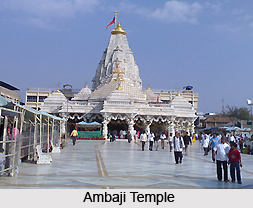 ocated in Ambaji Town, Patan city, the Ambaji temple, the holy seat of Amba Mata-the mother goddess, is an oft-visited site by the Hindus. It is considered as one of the `Shakti Peethas` in India. The Goddess is a manifestation of Lord Shiva`s consort, Parvati. Ambe Mata is `Adya Shakti`-the primeval female prowess as the mother goddess.
ocated in Ambaji Town, Patan city, the Ambaji temple, the holy seat of Amba Mata-the mother goddess, is an oft-visited site by the Hindus. It is considered as one of the `Shakti Peethas` in India. The Goddess is a manifestation of Lord Shiva`s consort, Parvati. Ambe Mata is `Adya Shakti`-the primeval female prowess as the mother goddess.
Ambaji Temple is located on the Arasur Hill, in the Aravalli Renge. The most enthralling feature of the shrine is that it does not contain any idol as such for the pilgrims` offerings. It has only a `yantra`, made of marble that is engraved in the chief spot in the sanctum sanctorum. Within a short distance from Ambaji Temple, there is a hill by the name Gabbar Hill. Devotees are of the belief that the Goddess had revealed herself on the hill, thereby leaving her footprints. She is even considered as the prime goddess of the region. This very reason has made the Hill a major attraction for tourists.
On Navratri tremendous festivals and fairs are organised, attended by numerous visitors, with great mirth and glory. Poornima (the night of the full moon) is also a special occasion for devotees visiting the Ambaji Temple, held in the months of Kartik, Chaitra and Bhadrapad.





















